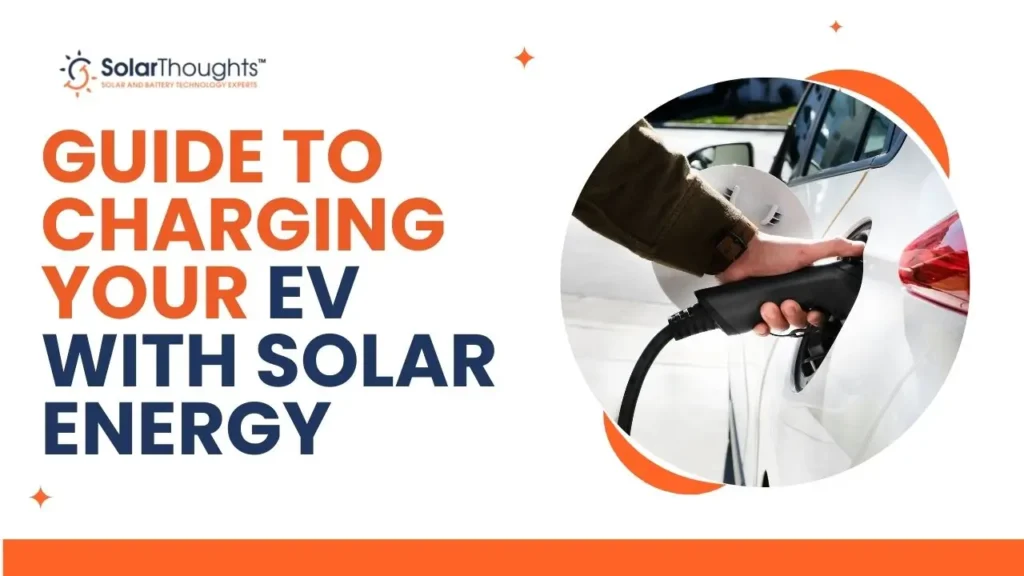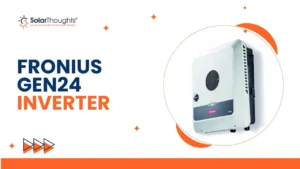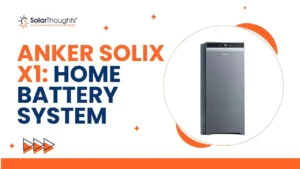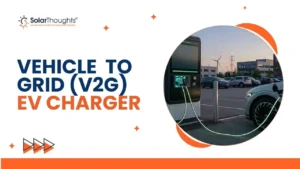As the world shifts towards sustainable transportation, electric vehicles (EVs) are becoming increasingly popular. However, the environmental benefits of EVs can be maximized by charging them with clean, renewable energy sources like solar power. This guide will walk you through the process of charging your EV with solar energy, helping you reduce your carbon footprint and potentially save money in the long run.
Table of Contents
Toggle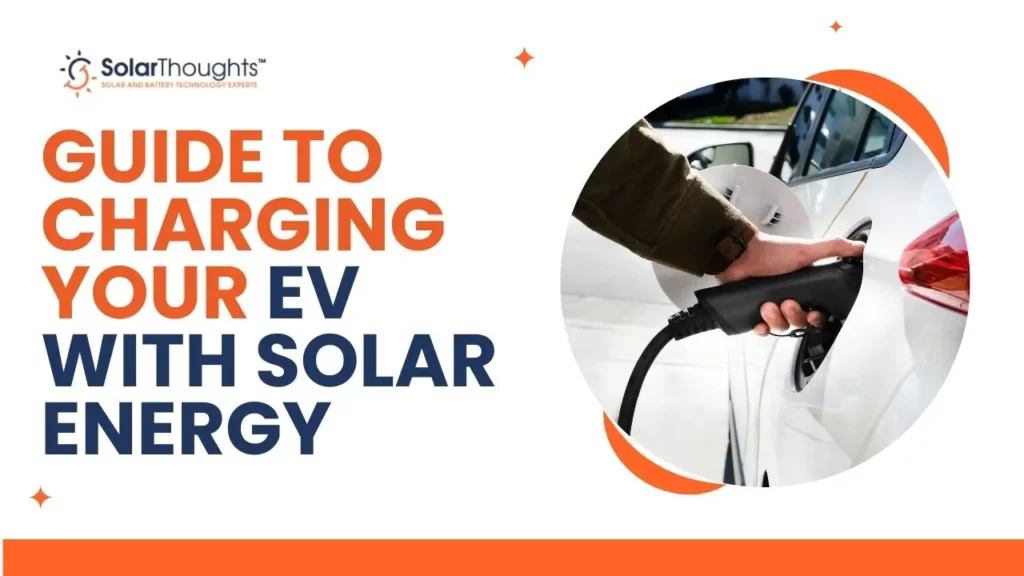
1. Understanding the basics of solar energy and EV charging
Before diving into the specifics of solar-powered EV charging, it’s essential to understand the basics of both solar energy and EV charging.
Solar energy is captured through photovoltaic (PV) panels, which convert sunlight into electricity. This clean, renewable energy can be used to power your home and charge your electric vehicle. The amount of energy produced depends on factors such as the size of your solar system, panel efficiency, and available sunlight.
EV charging, on the other hand, involves replenishing the battery of your electric vehicle. There are three main levels of EV charging:
Level 1: This is the slowest charging method, using a standard 120V household outlet. It typically adds about 4-5 miles of range per hour of charging.
Level 2: This faster charging method uses a 240V outlet and can add about 25-30 miles of range per hour.
Level 3 (DC Fast Charging): This is the fastest charging method, capable of adding up to 100-200 miles of range in just 30 minutes, depending on the vehicle and charger specifications.
When combining solar energy with EV charging, the goal is to use the electricity generated by your solar panels to power your EV charger, reducing your reliance on grid electricity and lowering your carbon emissions.
Also Read: Expert EV Charger Installation Services in Brisbane
2. How to choose the right EV charger for solar charging
Selecting the right EV charger for solar charging is crucial for maximizing efficiency and convenience. Here are some factors to consider:
Charging speed: For home use, a Level 2 charger is typically the best choice. It offers a good balance between charging speed and installation complexity.
Smart charging capabilities: Look for chargers with smart features that can communicate with your solar system and optimize charging based on available solar power.
Power output: Ensure the charger’s power output matches your EV’s onboard charger capacity. Most home Level 2 chargers range from 16 to 40 amps.
Connectivity: Wi-Fi-enabled chargers allow you to monitor and control charging remotely, which can be useful for scheduling charges during peak solar production times.
Weather resistance: If you plan to install the charger outdoors, make sure it’s rated for outdoor use and can withstand various weather conditions.
Safety certifications: Look for chargers with safety certifications from recognized organizations like UL or ETL.
Some popular EV charger brands that work well with solar systems include ChargePoint, JuiceBox, and Tesla Wall Connector (for Tesla vehicles). These chargers often come with apps that allow you to monitor your charging and integrate with your home energy management system.
Also Read: Best Solar Battery Backup System for Home
3. Sizing your solar system for EV charging
To effectively charge your EV with solar energy, you need to ensure your solar system is large enough to meet both your household energy needs and your EV charging requirements. Here’s how to size your solar system:
Calculate your current energy usage: Review your electricity bills to determine your average monthly energy consumption in kilowatt-hours (kWh).
Estimate your EV’s energy needs: Determine how many miles you drive per day and multiply this by your EV’s efficiency (kWh per mile). For example, if you drive 40 miles per day and your EV uses 0.3 kWh per mile, you’ll need 12 kWh per day for charging.
Add your household and EV energy needs: Combine your current energy usage with your EV’s energy needs to get your total energy requirement.
Account for solar panel efficiency: Solar panels typically operate at about 80% efficiency due to factors like weather and angle. Increase your energy requirement by 20% to account for this.
Consider your location: The amount of sunlight your location receives affects how much energy your panels can produce. Use online solar calculators or consult with a solar professional to determine how many panels you’ll need based on your location and energy requirements.
For example, if your household uses 900 kWh per month and your EV needs 360 kWh per month (12 kWh x 30 days), your total monthly requirement would be 1,260 kWh. Accounting for efficiency, you’d need a system capable of producing about 1,512 kWh per month.
Remember, it’s often better to slightly oversize your system to account for future increases in energy usage or the possibility of adding a second EV.
4. Best practices for optimizing your solar panels for EV charging
To get the most out of your solar panels for EV charging, consider these best practices:
Panel orientation and tilt: In the northern hemisphere, south-facing panels typically produce the most energy. The optimal tilt angle depends on your latitude, but a tilt equal to your latitude is a good rule of thumb.
Avoid shading: Ensure your panels are not shaded by trees, buildings, or other obstacles, especially during peak sunlight hours.
Regular maintenance: Keep your panels clean and free from debris to maintain optimal efficiency. Most panels are self-cleaning with rain, but occasional cleaning may be necessary in dry or dusty areas.
Use microinverters or power optimizers: These devices can help maximize the output of each individual panel, especially in cases of partial shading or panel mismatch.
Monitor system performance: Use your solar system’s monitoring tools to track performance and identify any issues quickly.
Consider a solar tracking system: While more expensive, tracking systems that adjust panel angles throughout the day can increase energy production by 25-35%.
Also Read: Common Types of Solar Panels
5. Smart chargers and tips for managing energy use during peak times
Smart EV chargers can help you optimize your charging schedule to make the most of your solar energy production. Here are some tips for managing your energy use:
Time-of-use scheduling: Program your charger to operate during peak solar production hours, typically between 10 am and 2 pm.
Dynamic power sharing: Some smart chargers can adjust their power draw based on the available solar energy, ensuring you’re using solar power whenever possible.
Grid export limiting: If your utility doesn’t offer net metering, consider a system that can divert excess solar energy to your EV charger instead of exporting it to the grid.
Weather-based charging: Some advanced systems can adjust charging schedules based on weather forecasts, maximizing solar usage on sunny days.
Vehicle-to-home (V2H) technology: Some newer EVs and chargers support V2H, allowing your car’s battery to power your home during peak demand times or outages.
Mobile app integration: Use your charger’s mobile app to monitor and adjust charging in real-time based on your solar production and energy needs.
Best Ev Charger Installer in Brisbane
6. Ways to store excess solar energy for later use
Solar energy production doesn’t always align perfectly with EV charging needs. Here are some ways to store excess energy for later use:
Home battery systems: Products like the Tesla Powerwall or LG Chem RESU can store excess solar energy for use during low-production hours or at night.
EV battery as storage: Some EVs, like the Ford F-150 Lightning, can act as a home battery, storing excess solar energy and powering your home when needed.
Thermal energy storage: Convert excess solar energy into heat, stored in well-insulated water tanks or other materials, which can be used for home heating or hot water.
Hydrogen production and storage: While still emerging, this technology converts excess electricity into hydrogen, which can be stored and later used in fuel cells.
Pumped hydro storage: For larger-scale applications, excess energy can be used to pump water uphill, which is later released through turbines to generate electricity when needed.
Grid energy storage: In some areas, utilities offer “virtual storage” programs where you can feed excess energy to the grid and receive credits for later use.
7. Strategies for saving money with solar-powered EV charging
Charging your EV with solar power can lead to significant savings over time. Here are some strategies to maximize your savings:
1) Take advantage of net metering: If available in your area, net metering allows you to sell excess solar energy back to the grid, offsetting the cost of grid electricity when you need it.
2) Utilize time-of-use (TOU) rates: If your utility offers TOU rates, charge your EV during off-peak hours when rates are lowest.
3) Maximize self-consumption: Try to use as much of your solar energy as possible by aligning your energy-intensive activities (including EV charging) with peak solar production times.
4) Consider a bi-directional charger: These allow your EV to feed energy back to your home or the grid, potentially earning you money or credits.
5) Explore solar renewable energy certificates (SRECs): In some states, you can earn and sell SRECs for the solar energy you produce, providing an additional income stream.
6) Leverage tax incentives: Take advantage of federal, state, and local tax incentives for both solar installation and EV charging equipment.
7) Regular system maintenance: Keep your solar panels and EV charger well-maintained to ensure they operate at peak efficiency, maximizing your energy production and savings.
By implementing these strategies, you can significantly reduce your energy costs while minimizing your carbon footprint.
Using solar power to charge your EV is a big move towards sustainable transportation and self-reliance in energy. When you match solar panels with clever EV charging systems, it helps greatly in lowering the amount of carbon emissions as well as expenditure on energy. Although setting up this system at first needs strategic planning and financial input, its advantages over time—both for environment and money—make it a worthy effort. The bonding of solar power and electric vehicles will become more powerful with the progressing technology, creating a path towards an environment that is cleaner and lasting.
Our Popular Services
Solar panels Brisbane | Solar Panel Installation Services | Upgrading existing Solar system | Solar Panel Repairs and Maintenance | Solar Panel Cleaning Service | Solar Battery Installations | Solar Inverter Installations

